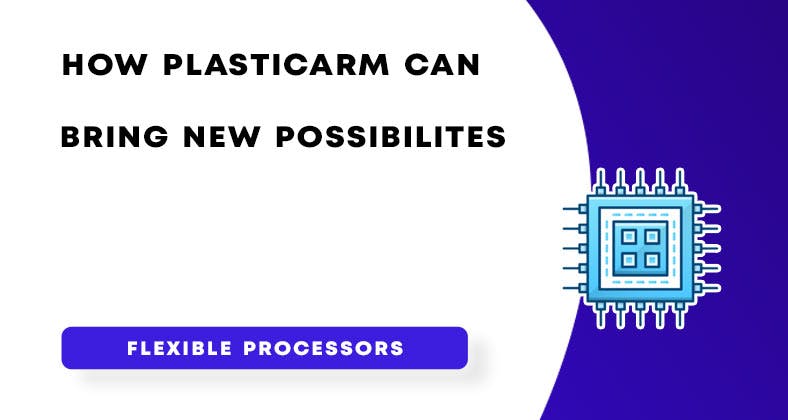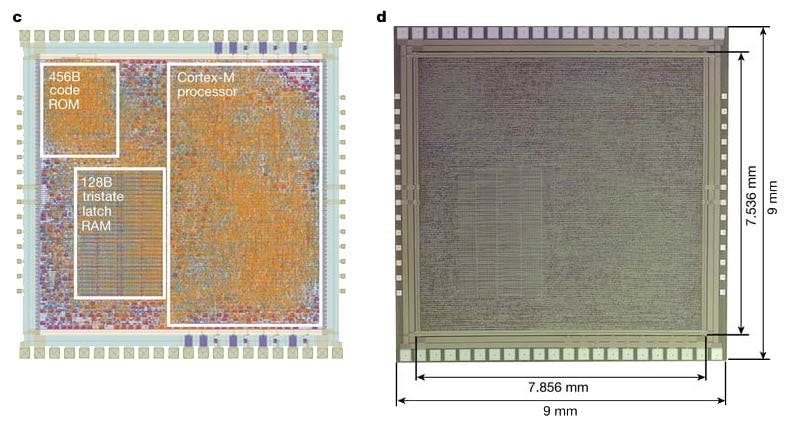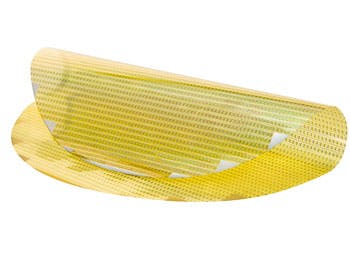How PlasticARM Flexible chips can reshape the Future
We have seen Microprocessors in a very decent manner, Mounted as a metal non-flexible Chip. Ever imagined a Bendable Microprocessor that can be made out of Plastic ( currently named PlasticARM ), without using Silicon, and can be embedded almost anywhere.
Though the experimental SoC is not much powerful at this time, it is possible to improve its efficiency by all means.

A research team from ARM (opens in a new tab), partnering with PragmatIC, began their journey of exploring the feasibility of an Arm-based flexible processor back in 2013. At that time, it wasn’t possible to produce a fully workable prototype. Recently in October 2020, the Team from ARM was able to produce the world’s first fully functional non-silicon Arm processor.
Specifications:
The PlasticARM is very much Complex in design than a usual Silicon-based system. It’s an ultra-minimalist Cortex-M0-based system on a chip (SoC), which runs on 32 Bit system & supports the ARMv6-M architecture, includes 128 bytes of RAM and 456 bytes of ROM.
Initially, this 32-bit processor includes 18,000 logic gates, memory, and a controller. Though researchers have claimed that future iterations could include up to 100,000 logic gates.

Previously, Flexible chips have been invented, but ARM’s device is the most powerful yet demonstrated. It has more than 50,000 components packed into less than 60 sq. millimeters. This gives it around 12 times more components to carry out calculations than the previous best-performing flexible chip.
The design is an integrated circuit built with metal-oxide TFTs ( Thin-film Transistors ) which can be fabricated on flexible substrates at a significantly lower processing cost than MOSFETs fabricated on crystalline silicon wafers.
Optimizing Opportunities:
PlasticARM can only achieve 29 KHz clock speeds at this point, which is really far away compared with Computer or even Mobile Processors that have a Frequency of 2-3Ghz or more based on specifications.
It consumes about 20 milliwatts of power, whereas the same ARM design on a Silicon chip uses around 10 microwatts of power. ARM still has to do improvement before a chip like this can actually fit in real-world devices.
Also Read: How RFID Works | Practical uses of it (opens in a new tab)
Potential of PlasticARM:
By using Non-silicon flexible Processors, numerous possibilities unfold, starting from embedding CPUs to essential plastic fabricated products to convert them to smart products, even using the Flexible CPUs with Biodegradable plastics (opens in a new tab).
You might have heard of Foldable smartphones before. In that scenario, the chips inside them don’t fold at all even when the phone does, that’s not needed in those kinds of devices.
But with the PlasticARM Concept, we will be able to implement Foldable processors in devices. It’s going to be a few years before we see anything like this running on a real device.

Possibilities:
The concept of a Foldable processor opens up a whole new area or topic to consider, completely related to the futuristic concepts that the majority of Engineers didn’t see coming such earlier.
PlasticArm will be bringing the possibility of seamlessly embedding billions of extremely low-cost, ultra-thin, conformable microprocessors into everyday objects or Devices.
For instance, according to the researchers- bottles, food packages, wearable patches, garments, and bandages as only a few applications of a flexible processor at this time.
As an efficient example, In the future, we could expect smart food packaging that can recognize the longevity of Packaged food inside them by processing the data like humidity conditions, heat, and other factors that the package has gone through.
Conclusion:
We have already discussed the potential possibilities in implementation that can be fulfilled in the next few decades. The Internet of Things is productive enough to give rise to an entire ecosystem of interconnected devices, objects, systems, and data all working together.
PlasticARM is an essential piece to the puzzle for the ambient computing future and the ecosystem that tech firms around the world are getting prepared to build.
If you are interested to learn more about the PlasticARM Processor and how it works, apart from the Articles by ARM, PragmatIC has also an Interview discussing everything about the Architecture. You can watch it from Here (opens in a new tab).
So this was a quick Informative tutorial about ARM’s PlasticARM processor. See you in the next article, till then, Signing off.
